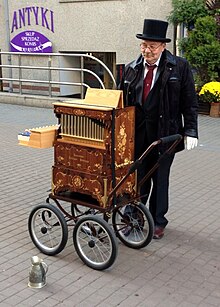
In music, the organ is a keyboard instrument of one or more pipe divisions or other means for producing tones. The organs have usually two or three, up to five, manuals for playing with the hands and a pedalboard for playing with the feet. With the use of registers, several groups of pipes can be connected to one manual.

The hurdy-gurdy is a string instrument that produces sound by a hand-crank-turned, rosined wheel rubbing against the strings. The wheel functions much like a violin bow, and single notes played on the instrument sound similar to those of a violin. Melodies are played on a keyboard that presses tangents—small wedges, typically made of wood or metal—against one or more of the strings to change their pitch. Like most other acoustic stringed instruments, it has a sound board and hollow cavity to make the vibration of the strings audible.

Book music is a medium for storing the music played on mechanical organs, mainly of European manufacture. Book music is made from thick cardboard, containing perforated holes specifying the musical notes to be played, with the book folded zig-zag style. Unlike the heavy pinned barrels, which could only contain a few tunes of fixed length, that had been used on earlier instruments, book music enabled large repertoires to be built up. The length of each tune was no longer determined by the physical dimensions of the instrument.
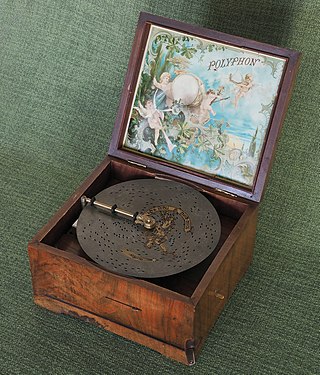
A music box or musical box is an automatic musical instrument in a box that produces musical notes by using a set of pins placed on a revolving cylinder or disc to pluck the tuned teeth of a steel comb. The popular device best known today as a "music box" developed from musical snuff boxes of the 18th century and were originally called carillons à musique. Some of the more complex boxes also contain a tiny drum and/or bells in addition to the metal comb.
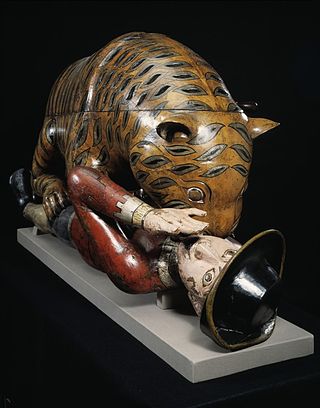
Tipu's Tiger or Tippu's Tiger is an 18th-century automaton or mechanical toy created for Tipu Sultan, the ruler of the Kingdom of Mysore in India. The carved and painted wood casing represents a tiger mauling a near life-size European man. Mechanisms inside the tiger and the man's body make one hand of the man move, emit a wailing sound from his mouth and grunts from the tiger. In addition a flap on the side of the tiger folds down to reveal the keyboard of a small pipe organ with 18 notes.

Orchestrion is a generic name for a machine that plays music and is designed to sound like an orchestra or band. Orchestrions may be operated by means of a large pinned cylinder or by a music roll and less commonly book music. The sound is usually produced by pipes, though they will be voiced differently from those found in a pipe organ, as well as percussion instruments. Many orchestrions contain a piano as well. At the Musical Museum in Brentford, London England, examples may be seen and heard of several of the instrument types described below.

The pump organ or reed organ is a type of free-reed organ that generates sound as air flows past a vibrating piece of thin metal in a frame. The piece of metal is called a reed. Specific types of pump organ include the American reed organ, the Indian harmonium, the physharmonica, and the seraphine. The idea for the free reed was derived from the Chinese sheng through Russia after 1750, and the first Western free-reed instrument was made in 1780 in Denmark.

A barrel piano is a forerunner of the modern player piano. Unlike the pneumatic player piano, a barrel piano is usually powered by turning a hand crank, though coin-operated models powered by clockwork were used to provide music in establishments such as pubs and cafés. Barrel pianos were popular with street musicians, who sought novel instruments that were also highly portable. They are frequently confused with barrel organs, but are quite different instruments.
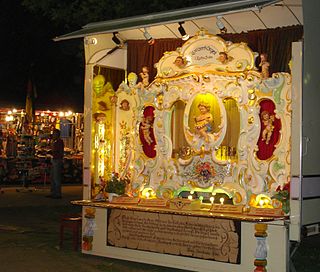
A fairground organ is a musical organ covering the wind and percussive sections of an orchestra. Originated in Paris, France, it was designed for use in commercial fairground settings to provide loud music to accompany rides and attractions, mostly merry-go-rounds. Unlike organs for indoor use, they are designed to produce a large volume of sound to be heard above the noises of crowds and fairground machinery.
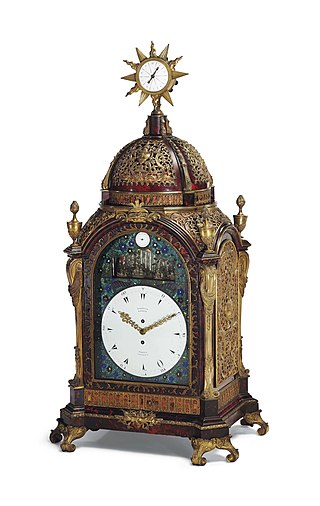
A musical clock is a clock that marks the hours of the day with a musical tune. They can be considered elaborate versions of striking or chiming clocks.
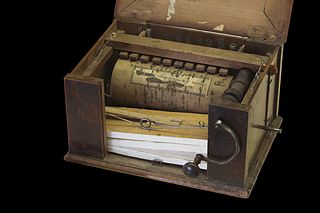
A serinette is a type of musical instrument consisting of a small hand-cranked, pneumatic barrel organ. It appeared in the first half of the 18th century in eastern France, and was used to teach tunes to canaries. Its name is derived from the French serin, meaning “canary.”

A street organ played by an organ grinder is a French automatic mechanical pneumatic organ designed to be mobile enough to play its music in the street. The two most commonly seen types are the smaller German and the larger Dutch street organ.
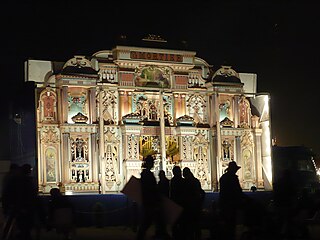
A dance organ is a French mechanical organ designed to be used in a dance hall or ballroom. Originated and popularized in Paris, it is intended for use indoors as dance organs tend to be quieter than the similar fairground organ.
A mechanical organ is an organ that is self-playing, rather than played by a musician. For example, the barrel organ is activated either by a person turning a crank, or by clockwork driven by weights or springs.
Gavioli & Cie were a Franco–Italian organ builder company that manufactured fairground organs in both Italy and later France.
The kaisatsuko is a mechanical experimental musical instrument invented by Yuichi Onoue of Tokyo, Japan.
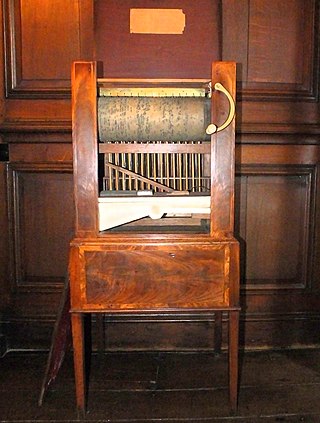
John Langshaw (1725–1798) was an English organist and an organ-builder. Leaving organ cases to others, he specialised in the mechanics, in particular those of chamber barrel organs. He left his native Lancashire to work in London, but returned to Lancashire in 1770.

Hurdy Gurdy is a 1929 animated short film which is presented by Carl Laemmle and was produced by Walter Lantz, who he and his wife would go on to make Woody Woodpecker. The film, which is animated by R.C. Hamilton, Bill Nolan and Tom Palmer, features Oswald the Lucky Rabbit, who is substituted for the organ grinder's dancer, after the original one is comically swallowed up by Oswald's bubblegum.
Traditional French musical instruments, known as instruments traditionnels in French, are musical instruments used in the traditional folk music of France. They comprise a range of string, wind, and percussion instruments.


